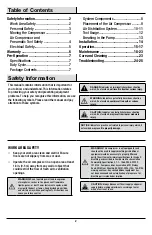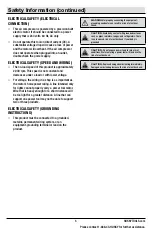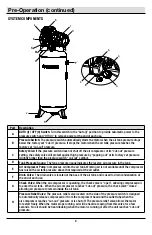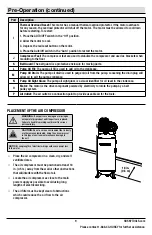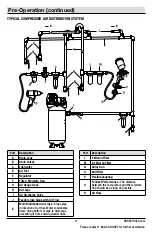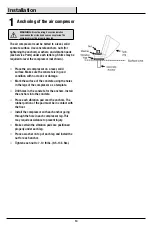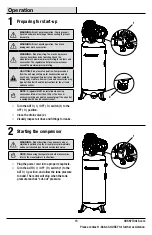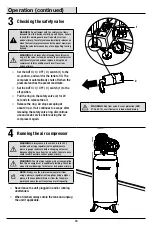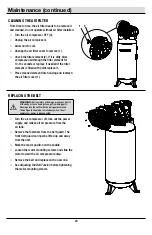
8
Part
Description
A
AUTO (I) / OFF (0) Switch:
Turn this switch in the “Auto (I)” position to provide automatic power to the
pressure switch and “Off (O)” to remove power at the end of each use.
B
Pressure Switch:
The pressure switch automatically starts the motor when the air tank pressure drops
below the factory set “cut-in” pressure. It stops the motor when the air tank pressure reaches the
factory set “cut-out” pressure.
C
Safety Valve:
If the pressure switch does not shut off the air compressor at its “cut-out” pressure
setting, the safety valve will protect against high pressure by “popping out” at its factory set pressure
(slightly higher than the pressure switch “cut-out” setting).
D
Tank Pressure Gauge:
The tank pressure gauge indicates the reserve air pressure in the tank.
E
Air Compressor Pump
: Compresses air into the air tank. Working air is not available until the compressor
has raised the air tank pressure above that required at the air outlet.
F
Drain Valve:
The drain valve is located at the base of the air tank and is used to drain condensation at
the end of each use.
G
Check Valve:
When the air compressor is operating, the check valve is “open”, allowing compressed air
to enter the air tank. When the air compressor reaches “cut-out” pressure, the check valve “closes”,
allowing air pressure to remain inside the air tank.
H
Pressure Relief Valve:
The pressure relief valve located on the side of the pressure switch is designed
to automatically release compressed air from the compressor head and the outlet tube when the
air compressor reaches “cut-out” pressure or is shut off. The pressure relief valve allows the motor
to restart freely. When the motor stops running, air will be heard escaping from this valve for a few
seconds. No air should be heard leaking when the motor is running or after the unit reaches “cut-out”
pressure.
SYSTEM COMPONENTS
Pre-Operation (continued)
A
G
D
B
C
E
L
N
M
I
O
H
P
K
J
F
E
L
N
M
I
O
H
P
K
J
F


